Abstract
Despite being rare, large volcanic eruptions can have a long-lasting impact on the chemistry, radiation, and dynamics of the stratosphere. This study attempts to quantify the changes in the stratospheric water vapour and its relationship to temperature and ozone observed from space-based Microwave Limb Sounder (MLS) observations during the submarine volcano eruption Hunga Tonga-Hunga Ha’apai that occurred on 15 January 2022. The most notable aspect of this eruption is the plumes, which are water vapour columns that reached higher altitudes (1 hPa (47.6 km)) than earlier eruptions. We discovered that the eruption injected a record amount of water vapour (6–8 ppmv) directly into the stratosphere from 38–10 hPa vertically, which is present even after one year. The majority of water vapour is confined to the Southern Hemisphere (SH) tropics, i.e., 30°S to 5°N, and gradually descends to the SH polar latitudes over time. The WV from the lower stratosphere reaches mesospheric altitudes during January 2023. We quantify the impact of increased water vapour on temperature and ozone as well. Temperatures begin to fall during the month of March in the regions where there is an increase in water vapour. A ~5 K cooling occurs in July and August as a result of the thermal adjustment to the extra water vapour IR cooling. Our analysis shows a decrease in ozone caused by an increase in water vapour. Significant variability is observed in all three parameters at 26 km compared to other levels. Further, we noticed that after one year of eruption, the water vapour, Temperature and Ozone did not reach the background values. It is possible that this unusual eruption produced a different atmospheric reaction than other significant volcanic eruptions that have been well investigated.
1. Introduction
Volcanic eruptions release large amounts of chemically and microphysically active gases and solid aerosol particles into the stratosphere, which influence the climate through radiative interactions and disrupt the stratosphere’s chemical equilibrium. Water vapour (WV), nitrogen (N2), carbon dioxide (CO2), sulphur dioxide (SO2), and ash are the main gases that volcanic eruptions release into the stratosphere [1]. After several weeks following the volcanic eruption, the Brewer–Dobson Circulation transports sulpate aerosols made from SO2 vertically and horizontally into the global stratosphere [2]. These sulphate aerosols transported to the polar stratosphere can serve as a surface for heterogeneous chemical reactions, resulting in ozone depletion [3,4]. These stratospheric aerosols absorb near-infrared outgoing longwave radiation from the troposphere and surface, which results in a decrease in surface temperature and an increase in the stratospheric temperature [5].
Volcanic eruptions have a significant impact on the earth’s radiation and chemical processes. For example, Mount Tambora (8.2°S, 118.0°E) in 1815 had the largest volcanic eruption in the last 500 years, with a Volcanic Explosivity Index (VEI) (The VEI describes the size of the explosive volcanic eruptions based on magnitude and intensity. The numerical scale from 0–8 is logarithmic and generally corresponds to the Richter and other magnitude scales for the size of earthquakes) of seven and an emission of 558 Tg mass of SO2. As a result of this eruption, several parts of the world witnessed a “Year without Summer” in 1816 [6,7]. Mount Agung (8°S, 116°E), Bali, Indonesia in March 1963; El Chichón (17°N, 93°W), Chiapas, Mexico in April 1982; and Mount Pinatubo (15°N, 120°E), Luzon, Philippines in June 1991 were the three largest volcanic eruptions that occurred since the late 1950s and had a significant impact on the global climate. The VEI values for all three eruptions were 4, 5, and 6, respectively. Mount Pinatubo’s (VEI = 6) eruption in 1991 affected global mean surface temperature by 0.2–0.3 °C up to two years after the eruption [8].
Despite the fact that volcanic eruptions inject large amounts of gases into the stratosphere, including water vapour, nitrogen, and carbon dioxide, it is believed that sulphur-containing gases are the most injected gases [9]. Volcanic eruptions via volcanic aerosols enhance tropopause temperatures, permitting direct injection of water vapour into stratospheric altitudes. The interaction of newly generated sulphuric acid aerosols, radiation, and chemistry causes a drop in surface temperature and stratospheric ozone [4]. Furthermore, volcanic aerosols change the chemistry of the stratosphere dramatically. The ozone is the primary driver of chemical changes in the stratosphere, which influences the ultraviolet and longwave radiative fluxes. Several studies have focused on the impact of volcanic eruptions on the dynamics, chemistry, and radiation of the stratospheric region using observational and modeling data [10]. This study examined the changes in water vapour, temperature, and ozone caused by the Hunga Tonga-Hunga Ha’apai eruption using observational data sets such as water vapour, temperature, and ozone from MLS observations.
2. Eruption Status
Hunga Tonga-Hunga Ha’apai (20.57°S, 175.38°W) (hereafter referred to as Hunga Tonga (HT)), located near the South Pacific island of Tonga, erupted on 15 January 2022 at 04:02 UTC [11], with an estimated SO2 burden of 0.4–0.5 Tg, far less than the injected SO2 by previous volcanos [12]. Despite the lower SO2 burden, this eruption has a VEI of five, with explosive intensity comparable to Mount Pinatubo, and its features are exceptional in several ways [13]. The eruption injected volcanic material into the mesosphere to an altitude of 57 km, with major plume material detrained between 26 and 34 km [14,15]. Another significant characteristic of this HT eruption was the plume, which carried enormous volumes of WV directly into the stratosphere, increasing the overall WV concentration by 10% [16,17]. In contrast to landlocked volcanic eruptions such as Tambora, El Chichon, and Pinatubo, this undersea eruption has the ability to inject massive volumes of WV directly into the stratosphere.
The HT caldera is located below 150 metres of sea level, where the water collides with erupting magma (at temperatures up to 1000 degrees Celsius). This eruption injected at least 50 Tg of WV into the stratosphere, as indicated by in situ radiosonde measurements from weather balloons. The exclusive nature of the plume content and the height of the injection in the stratosphere, attracted immediate attention and sparked several scientific discussions and scientific exchanges with the atmospheric community [18,19]. This eruption disrupted the WV tape recorder signal, and the WV injection bypassed the cold point tropopause, reaching a record injection height (53 km) in the 17-year MLS satellite observation period [18]. This eruption caused the highest increase in stratospheric aerosol optical depth since the Pinatubo eruption [19]. A large amount of WV injection into the stratosphere can result in significant perturbations to stratospheric aerosol evolution due to the faster conversion of SO2 to sulphate as reported by [20]. Using HIMAWARI and CALIOP satellite observations, Legras et al. (2022) reported that the plume is primarily composed of sub-micron sulphate particles and is devoid of ash particles [21]. After a week, balloon measurements over La Réunion island revealed that the plume was composed of very small particles (with a “radius of 1 μm”) [22]. The short-term radiative impacts of the eruption’s perturbation in the stratospheric WV and aerosol were investigated by [18]. During the first three weeks, volcanic aerosol cooling dominates the radiative forcing both at the surface and at the top of the atmosphere (TOA). After three weeks, WV heating dominates the TOA radiative force, resulting in net warming.
Unlike previous volcanic eruptions, the HT explosions injected WV into stratospheric altitudes, which is unique in terms of dynamics, chemistry, and radiation. Previous studies focused on the injection of water vapour, aerosols by HT explosion [17,18,19]. However, this study focused on water vapour transport and its relation to temperature and ozone. Here, in this study, we discuss the changes in stratospheric WV (vertical, zonal, meridional, and spatial variation), and its relation with temperature (T) and ozone (O3). Section 3 provides a summary of the data sets used in the study. Section 4 discusses the MLS observations of injected WV by the HT-HH volcanic explosion, as well as its relationship to T and O3 in terms of long-term data. Section 5 briefly presents the discussion and finally, Section 6 discusses the summary and conclusions.
3. Dataset
3.1. MLS Observations
Since August 2004, the Microwave Limb Sounder (MLS) on the Earth Observation System Aura satellite has been providing temperature and chemical constituent profiles. The water vapour (WV), temperature (T) and ozone (O3) data are available globally in the latitude range of 82°S–82°N at 55 different pressure levels. The temperature profiles are retrieved using the radiances near the O2 spectral bands at 118 GHz (for stratosphere and above) and 239 GHz (for troposphere), WV and O3 at 190 GHz and 240 GHz, respectively. We have gridded all three parameters to 5° × 5° latitude and longitude grid daily. The retrieval algorithm description, measuring technique, and the accuracy of the measurements are explained in detail by [23,24]. The estimated single precisions of WV between 316 hPa–100 hPa, 100 hPa–1 hPa, and 1 hPa–0.1 hPa are ~15%, ~0.1, and ~0.3 ppmv, respectively. WV measurements have an accuracy of 4–8.3% in the pressure range of 100 hPa–18 hPa [25]. The vertical resolution of O3 retrievals in the stratosphere is 3 km, while temperature measurements between 261–0.01 hPa have a vertical resolution of 3 to 6 km. We used version 5 of level products (T, WV, and O3) downloaded from http://mirador.gsfc.nasa.gov (accessed on 5 February 2023) for the period January 2005–January 2023 in this study.
3.2. MERRA-2 Reanalysis Products
MERRA-2 (Modern-Era Retrospective analysis for Research and Applications. MERRA-2) is NASA’s most recent global atmospheric re-analysis system, developed with Goddard Earth Observing System Model (GEOS) [26] and Gridpoint Statistical Interpolation (GSI) analysis scheme [27]. The MERRA-2 reanalysis provides meteorological fields (T, wind components, vertical pressure velocity, WV, O3 mixing ratio, and other parameters) at a horizontal resolution of 0.625° × 0.5° in longitude and latitude at 72 model levels or interpolated to 42 pressure levels. From 1980 to the present, these fields are available every three hours between 00:00 UTC and 21:00 UTC, with a three-week latency after the end of a month. We used T, zonal wind (U), and meridional wind (V) data from https://disc.gsfc.nasa.gov/datasets (accessed on 5 February 2023) for the period January 2005 to December 2022 in this study. Throughout the paper, we discussed the mean long-term anomaly, which is the difference between 2022 and the mean of the years 2005–2021.
4. Results
Figure 1 depicts the daily mean (2005:2021) profiles, daily (January 2022 to January 2023) profiles, and their difference in WV, T, and O3 averaged throughout the longitudes and 30°S–5°N latitude band obtained from MLS satellite observations. Changes in WV daily profiles represent strong enhancement after the 15 January 2022 eruption (Figure 1c) and subsequent months (significantly higher up to June) when compared to the climatological average profiles (2005 to 2021) (Figure 1a). The HT eruption injected the WV over a vast vertical range, comprising the bulk of the stratosphere between 38 and 17 hPa (22.2–27 km). The changes in WV (Figure 1c) clearly reveal an increase in WV of about 5 ppmv. The enhancement in WV is observed throughout the band and reaches to higher altitude (mesospheric) in January 2023. The HT eruption plume directly injected a large amount of WV into the mid and upper stratosphere via strong upwelling. The vertical extent and duration of hydration are significantly larger than previously observed volcanic eruptions [28]. The WV plume moves towards higher altitudes from September onwards.
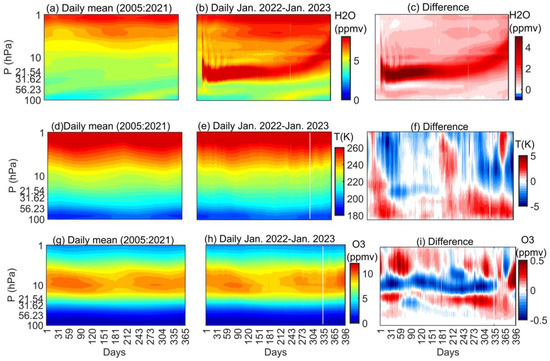
Figure 1.
(a) Daily averaged profiles of water vapour mixing ratio from 2005 to 2021, (b) Daily profiles of water vapour mixing ratio from 1 January 2022 to 31 January 2023, (c) Day wise anomaly (2022- (2005 to 2021)) in water vapour mixing ratio. (d–i) same as (a–c) but for Temperature and ozone, respectively. All these profiles are averaged throughout the longitudes, and 30°S–5°N latitude band.
Changes in T show a significant increase in T from 100 to 10 hPa after the eruption compared to previous days (prior to 14 January 2022). Between the 15th and 31st of January 2022, there is a considerable increase in T (about 80 hPa) as a result of the HT eruption (Figure 1f). The temperature begins to fall in February onwards and reaches maximum decrease during July. The volcanic eruption initially releases latent heat, elevating temperatures in the lower and upper stratospheres. Significant cooling occurs as WV increases, lowering middle and high stratospheric temperatures. The T anomaly decreases with respect to days and with an increase in altitude. Again, the T anomaly begins to increase at lower altitudes beginning in September and continuing until January 2023. Figure 1i indicates a modest increase in O3 at 23 hPa and a drop at 10 hPa. The average deviation is 0.5 ppmv. In January and February, there is a modest increase in O3 from 56 to 20 hPa, followed by a decline. At 10 hPa, O3 decreases on all days and increases later (January to August).
To further quantify the spatial extent of WV, we averaged the data zonally and vertically between 38–10 hPa. Figure 2a depicts the long-term difference ((2005: 2021-(January 2022: January 2023)). WV has a latitudinal range of 35°, or from 30°S to 5°N. In April, WV begins to fall towards the SH polar latitude and reaches the poles in November, whereas in NH, WV reaches midlatitudes in December. There were also obvious variations in the wind around regions with higher WV. The magnitude of wind changes is depicted by wind vectors, which are usually directed towards greater WV.
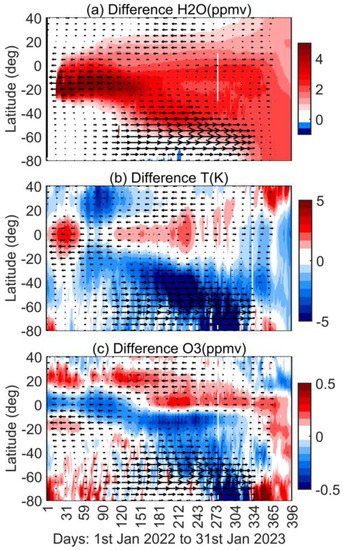
Figure 2.
(a) Day wise anomaly (January 2022 to January 2023-(2005 to 2021)) in water vapour mixing ratio, (b) Temperature, and (c) ozone with respect to latitude, averaged throughout the longitudes and 38–10 hPa vertically. The MERRA-2 wind vectors are also plotted during January 2022 to December 2022.
The T rises initially from January to the middle of February, then decreases (Figure 2b). Cooling is observed below 20°S and is continuous throughout the months up to November. From March through November, the cooling continues to redistribute towards the south. The drop in O3 is more pronounced in terms of day-to-day meridional fluctuation (Figure 2c). From May to November, there is a drop in O3, as well as an increase in eastward wind at latitudes ranging from 60°S to 30°S.
4.1. Changes in Water Vapuor
Figure 3 and Figure S1 present the zonal and meridional variation in monthly mean WV anomaly with respect to altitude from January 2022 to January 2023. Figure S1 shows a large spread of WV across the longitude bands when averaged between 30°S and 5°N. The majority of the WV is confined within a pressure range of 38–10 hPa. The magnitude is high from February to April and gradually decreases. The large WV signatures move toward the higher altitudes. In terms of meridional variation, the vertical extent of the plume from 68 hPa to 1 hPa is depicted in January compared to other months (Figure 3a). During February, March, and April, two separate plumes were seen, one in the lower stratosphere (90 to 70 hPa) and the other in the upper stratospheric (46 to 1 hPa). The mid and upper stratospheres have a higher WV than the lower stratosphere. From January 2022 (Figure 3a) through January 2023 (Figure 3m), the stratospheric WV ascends to higher elevations. Furthermore, the meridional variation demonstrates the geographical extension of WV towards tropical latitudes.
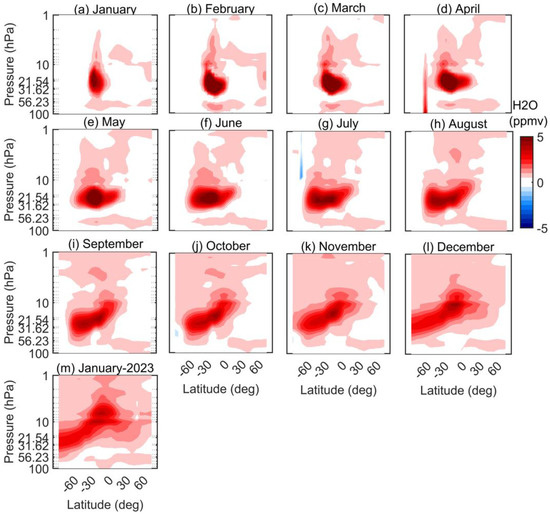
Figure 3.
Meridional variation of monthly ((a–m) for different months) mean water vapour mixing ratio anomaly (January 2022 to January 2023-(2005 to 2021)) obtained from MLS. The data are averaged throughout the longitude bands.
Figure 4 and Figure S2 depict the monthly mean spatial variation of WV anomaly from January 2022 to January 2023 at three different pressure levels. The amount of WV at 31 hPa (23 km) is highest in February and March and the magnitude decreases in other months. The WV dispersion starts from May towards the SH polar latitudes and is confined to polar latitudes during January 2023. From March to August, a significant amount of WV is observed at 21.54 hPa (26.30 km) and magnitude decreases as WV disperses towards SH polar latitudes The amount of WV attained at 10 hPa (31.80 km) is quite low compared to other altitudes. The WV increases at 10 hPa from September onwards (Figure S2). The dispersion of WV towards SH is substantial at 31 and 21 hPa levels. From January 2022 to January 2023, the spread of WV increases at all pressure levels. The injection of WV is limited to 46 hPa in most of the previous volcanos whereas the HT volcano reached ~10 hPa [29,30]. WV signatures are found up to 1 hPa (Figure 1c). The WV gradually widened and dispersed towards the SH latitudes. The volcanic eruption is pushed upward by the eruption through release of latent heat at lower altitudes (i.e., in troposphere) which increase temperature. This creates the channel for significant amount of WV to be transported during volcanic eruptions [31].
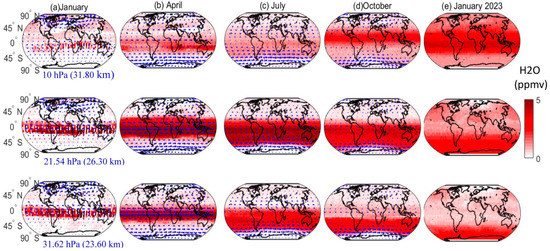
Figure 4.
Spatial variation of monthly (a–e) mean anomaly (January 2022 to January 2023-2005 to 2021) in water vapour mixing ratio at 3 different pressure levels for different months obtained from MLS along with the MERRA-2 wind vectors of the year 2022.
4.2. Changes in Temperature
An increase in the T anomaly is observed from 100-21hPa throughout during longitudes from January to March and later decreases (from April to July) throughout the longitudes. A moderate increase in T is observed from October 2022 to January 2023 in a similar band. The monthly mean anomaly in a meridional variation of T shows an increase in the 38–10 hPa range (Figure 5) in the latitude band of −30o to 30o. In terms of altitude, the increase is greatest in February, followed by January and March. Later, a decrease in T is observed up to July. T increases throughout tropical latitudes from August 2022 to January 2023. Figure 6 and Figure S4 depict the spatial variation of the monthly mean T anomaly at three different pressure levels from January 2022 to January 2023 months. The decrease in T (~5 K decrease) at all the pressure levels from March to November SH polar latitudes is noticed. During January 2023, T comes to normal background values in SH.

Figure 5.
Meridional variation of monthly(a–m) mean temperature anomaly (January 2022 to January 2023-(2005 to 2021)) obtained from MLS. The data is averaged throughout the longitude bands.
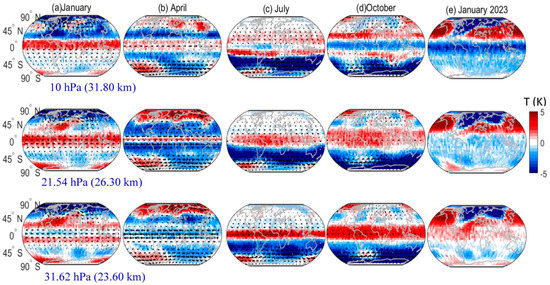
Figure 6.
Spatial variation of monthly (a–e) mean anomaly (January 2022 to January 2023-2005 to 2021) in temperature at 3 different pressure levels for different months obtained from MLS along with the MERRA-2 wind vectors of the year 2022.
4.3. Changes in Ozone
The monthly mean zonal variation of O3 anomaly averaged between 30°S and 5°N shows a slight decrease at 10 hPa (Figure S5). In terms of meridional variation, a decrease in O3 is observed exactly above the equator in all months in the altitude range of 21-10 hPa (Figure 7). During the months of June to August, the decrease in O3 is more pronounced over the eruption region. This is reflected in the significant decrease in T in this region. From January to August, the monthly mean spatial variation of the O3 anomaly shows a decreasing pattern at 10 hPa (Figure 8 and Figure S6). A large decrease in O3 is noticed at 31.60 hPa from March to November in SH. Except for March and April, all other months show an increase in O3 near the equator and this increase spreads throughout the globe up November and decreases later at 21.54 hPa. A significant decrease is observed during the months of July and October at 31.61 hPa when compared to other pressure levels.
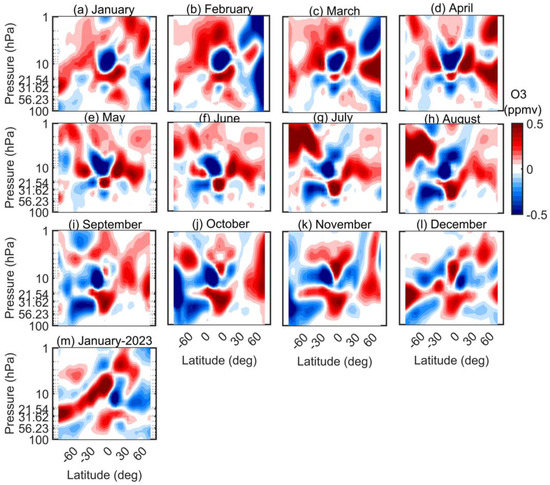
Figure 7.
Meridional variation of monthly (a–m) mean ozone anomaly (January 2022 to January 2023-(2005 to 2021)) obtained from MLS. The data is averaged throughout the longitude bands.
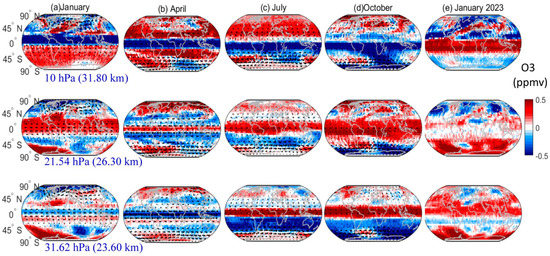
Figure 8.
Spatial variation of monthly (a–e) mean anomaly (January 2022 to January 2023-2005 to 2021) in ozone at 3 different pressure levels for different months obtained from MLS along with the MERRA-2 wind vectors of the year 2022.
5. Discussion
The submarine HT volcanic eruption, which occurred only a few tens to hundreds of meters below the water, the explosion propelled into the stratosphere [14]. It condensed at the lower altitudes (i.e., in troposphere), instantly releasing latent heat near and across a few tens of kilometres [31]. The strong and short-lived forcing produced vertically deep waves that penetrated and transported a large amount of WV into the stratosphere. The initial temperature of the plume is most likely higher than the ambient temperature at the stratospheric heights (Figure 1f). The presence of WV in the stratosphere in this case is due to the transport through volcanic clouds heating the tropopause (Figure S7). The plumes shear out and plume T cools to ambient temperature within days or weeks. As discussed by Solomon et al. (2010) and Clyne et al. (2010), an increase in stratospheric WV may result in stratospheric cooling [32,33]. Thus, the stratospheric WV contributed to cooling beginning in mid-February, and cooling increased noticeably as the months progressed (up to November) (Figure 6).
The climatic effects of this eruption are likely to differ from those of other volcanoes due to the higher altitude of WV injection (for example, the Pinatubo eruption). The decrease in T after February corresponds to an increase in WV at that altitude (Figure 6). It is also clear from spatial variation that a significant decrease in T coincides with an increase in WV. The decrease in T can be attributed to IR cooling accompanied by an increase in water vapour [34]. According to Silletto et al. (2022), short-wave heating and long-wave cooling by aerosols appear to cancel [18]. As a result, temperature changes caused by the radiative response to increased WV IR cooling occur. Furthermore, the increased WV caused by the eruption is likely to alter the chemical cycles that control stratospheric O3. Increased WV causes increased concertation of OH radicals via the reaction of H2O with O (1 D) oxygen atoms, which may reduce the amount of O3 in the WV layer. Stratospheric O3 influences T changes by absorbing solar radiation. The T changes are caused primarily by radiative absorption by volcanic aerosols, which is then superimposed by cooling caused by reduced O3 (Figure 8). The decrease in O3 at 10 hPa is caused in part by the chemical effect. The decrease in O3 is clearly visible following the HT-HH eruption, which could be due to additional heating caused by volcanic eruption [1]. This heating causes isentropic surfaces to lift, allowing stratospheric O3 to be transported. Further, the decrease in O3, in the stratosphere results in the decrease of temperature and vice versa since O3 is the major heat source in the stratosphere. In stratosphere, another mechanism for the enhancement of water vapour is due to the oxidation of methane generates the HOx radicals that catalytically destroy ozone [35,36] but may not be that dominant during this eruption. Further, we have taken the monthly mean anomaly between 2021 and 2005–2020 years to verify whether the eruption impact on WV, T and O3 came to the background or not. Our results demonstrated that, the water vapour at 30 hPa increased significantly from November 2022 compared to previous months. The WV reaches the mesospheric altitudes from stratospheric levels. The WV, T, and O3 did not reach their background even after the completion of one year of the eruption.
6. Summary and Conclusions
We presented an analysis with a focus on the changes noticed in water vapour, temperature, and ozone caused by HT-HH volcanic eruption using long-term MLS observations. The major findings obtained from the present study are summarised in the following.
- One of the most notable characteristics of this HT explosion is the highest altitude (to stratospheric altitudes (1 hPa, or 47.6 km)) of ejection of water vapour (Figure 1c), which was not seen in previous eruptions (Murcray et al., 1981; Glaze et al., 1997; Joshi et al., 2009; Sioris et al., 2016) [28,33,37,38].
- The water vapour injected into the stratosphere by the HT volcanic eruption remains in the stratosphere for several months (from January 2022 to January 2023). In terms of spatial variation, it is observed that water vapour disperses towards SH polar latitudes from January 2022 to January 2023 (Figure 4). During January 2023, the stratospheric water vapour reaches the mesospheric altitudes from stratospheric levels. The increase in stratospheric water vapour does not remain constant throughout the year due to the dynamics involved but varies with the seasons [39,40,41].
- A considerable amount of water vapour is seen at 21.54 hPa (26.30 km) compared to other altitudes (Figure 4). During volcanic eruption, the release of latent heat through condensation of water vapour at lower altitudes accelerates plume ascent, significantly increasing stratospheric water vapour.
- Our finding shows an increase in temperature immediately following the volcanic eruption (Figure 5c). Later, a significant decrease in temperature (cooling) is observed in SH due to IR radiative cooling via water vapour. Increased water vapour reduces stratospheric temperature while increasing the amount of odd hydrogen. Furthermore, increased water vapour results in cooling throughout the stratosphere, with the greatest values in the polar lower stratosphere (Figure 6).
- The cooling reaches a maximum of around ~5 K from May to November, with strong dispersion towards SH polar latitudes due to the significant increase in water vapour (Figure 6).
- A decrease in the ozone is observed due to an increase in water vapour at stratospheric altitudes (Figure 8). Because of increased water vapour in the stratosphere, OH concentrations rise, slightly increasing O3 production via the CH4 oxidation cycle but worsening O3 depletion via the HOx cycle, resulting in a net decrease in O3 [42,43].
- Even after one year of completion of eruption, the WV, T, and O3 did not reach to their background values.
Our study focused solely on the impact of HT volcanic explosions on the stratospheric water vapour, temperature, and ozone, as well as their interactions. The presence of HT eruption in the stratosphere has been observed for several months. Future research should be carried out to better understand the impact of stratospheric water vapour on its radiative forcing, circulation changes, detailed chemistry, and the impact of water vapour on the SO2 oxidation process.
Supplementary Materials
The following supporting information can be downloaded at: https://www.mdpi.com/article/10.3390/rs15143602/s1, Figure S1: Zonal variation of monthly mean water vapor anomaly (January 2022 to January 2023- (2005 to 2021)) obtained from MLS. The data is averaged between 30°S to 5°N latitude; Figure S2: Spatial variation of monthly mean anomaly (January 2022 to January 2023-2005 to 2021) in water vapor mixing ratio at 3 different pressure levels for different months obtained from MLS along with the MERRA-2 wind vectors during the years 2022; Figure S3: Zonal variation of monthly mean temperature anomaly (January 2022 to January 2023- (2005 to 2021)) obtained from MLS. The data is averaged between 30°S to 5°N latitude; Figure S4: Spatial variation of monthly mean anomaly (January 2022 to January 2023-2005 to 2021) in temperature at 3 different pressure levels for different months obtained from MLS along with the MERRA-2 wind vectors during the years 2022; Figure S5: Zonal variation of monthly mean ozone anomaly (January 2022 to January 2023- (2005 to 2021)) obtained from MLS. The data is averaged between 30°S to 5°N latitude; Figure S6: Spatial variation of monthly mean anomaly (January 2022 to January 2023-2005 to 2021) in water vapor mixing ratio at 3 different pressure levels for different months obtained from MLS along with the MERRA-2 wind vectors during the years 2022; Figure S7: Daily variation of water vapor mixing ratio and temperature from 14–20 January 2022 averaged throughout the longitudes, and 30°S–5°N latitude band.
Author Contributions
Conceptualisation, G.B.; methodology, G.B. and J.H.J.; software, P.K.; validation, S.R.B.; formal analysis, P.K.; investigation, G.B.; resources, P.K.; data curation, A.H.K. and S.R.B.; supervision, M.V.R. and J.H.J.; writing—original draft, G.B.; writing—review and editing, M.V.R., A.H.K. and J.H.J. All authors have read and agreed to the published version of the manuscript.
Funding
This work was supported by the National Atmospheric Research Laboratory.
Data Availability Statement
Publicly available satellite datasets were analysed in this study. These datasets can be found here: MLS and MERRA 2 websites.
Acknowledgments
Author J.H.J. acknowledges the support by the Jet Propulsion Laboratory, California Institute of Technology, under contract with NASA. Alladi Hemanth Kumar acknowledges the Department of Science and Technology (DST), Government of India for providing financial support in the form of fellowship during the course of this work through DSTINSPIRE Faculty scheme (Faculty Registration No. IFA 18-EAS 76 and 380 DST/INSPIRE/04/2018/003767).
Conflicts of Interest
The authors declare no conflict of interest.
References
- Kilian, M.; Brinkop, S.; Jöckel, P. Impact of the eruption of Mt Pinatubo on the chemical composition of the stratosphere. Atmos. Chem. Phys. 2020, 20, 11697–11715. [Google Scholar] [CrossRef]
- Butchart, N. The Brewer-Dobson Circulation. Rev. Geophys. 2014, 52, 157–184. [Google Scholar] [CrossRef]
- Zhu, Y.; Toon, O.B.; Kinnison, D.; Harvey, V.L.; Mills, M.J.; Bardeen, C.G.; Pitts, M.; Bègue, N.; Renard, J.; Berthet, G.; et al. Stratospheric aerosols, polarstratospheric clouds, and polar ozonedepletion after the Mount Calbucoeruption in 2015. J. Geophys. Res. Atmos. 2018, 123, 12308–12331. [Google Scholar] [CrossRef]
- Xia, L.; Nowack, P.J.; Tilmes, S.; Robock, A. Impacts of stratospheric sulfate geoengineering on tropospheric ozone. Atmos. Chem. Phys. 2017, 17, 11913–11928. [Google Scholar] [CrossRef]
- Robock, A. Volcanic eruptions and climate. Rev. Geophys. 2000, 38, 191–219. [Google Scholar] [CrossRef]
- Gao, C.; Gao, Y.; Zhang, Q.; Shi, C. Climatic Aftermath of the 1815 Tambora Eruption in China. J. Meteorol. Res. 2017, 31, 28–38. [Google Scholar] [CrossRef]
- Raible, C.C.; Brönnimann, S.; Auchmann, R.; Brohan, P.; Frölicher, T.L.; Graf, H.-F.; Jones, P.; Luterbacher, J.; Muthers, S.; Neukom, R.; et al. Tambora 1815 as a test case for high impact volcanic eruptions: Earth system effects. Wiley Interdiscip. Rev. Clim. Chang. 2016, 7, 569–589. [Google Scholar] [CrossRef]
- Stenchikov, G.; Robock, A.; Ramaswamy, V.; Schwarzkopf, M.D.; Hamilton, K.; Ramachandran, S. Arctic Oscillation response to the 1991 Mount Pinatubo eruption: Effects of volcanic aerosols and ozone depletion. J. Geophys. Res. Atmos. 2002, 107, ACL 28-1–ACL 28-16. [Google Scholar] [CrossRef]
- Fischer, T.P.; Aiuppa, A. AGU Centennial Grand Challenge: Volcanoes and deep carbon global CO2 emissions from subaerial volcanism—Recent progress and future challenges. Geochem. Geophys. Geosyst. 2020, 21, e2019GC008690. [Google Scholar] [CrossRef]
- Ravindra Babu, S.; Liou, Y.-A. Day-to-day variability of upper troposphere and lower stratosphere temperature in response to Taal volcanic eruption inferred from COSMIC-2 RO measurements. J. Volcanol. Geotherm. Res. 2022, 421, 107445. [Google Scholar] [CrossRef]
- Yuen, D.A.; Scruggs, M.A.; Spera, F.J.; Zheng, Y.; Hu, H.; McNutt, S.R.; Thompson, G.; Mandli, K.; Keller, B.R.; Wei, S.S.; et al. Under the surface: Pressure-induced planetary-scale waves, volcanic lightning, and gaseous clouds caused by the submarine eruption of Hunga Tonga-Hunga Ha’apai volcano. Earthq. Res. Adv. 2022, 2, 100134. [Google Scholar] [CrossRef]
- Witze, A. Why the Tongan eruption will go down in the history of volcanology. Nature 2022, 602, 376–378. [Google Scholar] [CrossRef] [PubMed]
- Poli, P.; Shapiro, N.M. Rapid Characterization of Large Volcanic Eruptions: Measuring the Impulse of the Hunga Tonga Ha’apai Explosion From Teleseismic Waves. Geophys. Res. Lett. 2022, 49, e2022GL098123. [Google Scholar] [CrossRef]
- Carr, J.L.; Horváth, Á.; Wu, D.L.; Friberg, M.D. Stereo Plume Height and Motion Retrievals for the Record-Setting Hunga Tonga-Hunga Ha’apai Eruption of 15 January 2022. Geophys. Res. Lett. 2022, 49, e2022GL098131. [Google Scholar] [CrossRef]
- Proud, S.R.; Prata, A.T.; Schmauß, S. The January 2022 Eruption of Hunga Tonga-Hunga Ha’apai Volcano Reached the Mesosphere. Science 2022, 378, 554–557. [Google Scholar] [CrossRef] [PubMed]
- Millán, L.; Santee, M.L.; Lambert, A.; Livesey, N.J.; Werner, F.; Schwartz, M.J.; Pumphrey, H.C.; Manney, G.L.; Wang, Y.; Su, H.; et al. The Hunga Tonga-Hunga Ha’apai Hydration of the Stratosphere. Geophys. Res. Lett. 2022, 49, e2022GL099381. [Google Scholar] [CrossRef]
- Vömel, H.; Evan, S.; Tully, M. Water vapor injection into the stratosphere by Hunga Tonga-Hunga Ha’apai. Science 2022, 377, 1444–1447. [Google Scholar] [CrossRef]
- Sellitto, P.; Podglajen, A.; Belhadji, R.; Boichu, M.; Carboni, E.; Cuesta, J.; Duchamp, C.; Kloss, C.; Siddans, R.; Bègue, N.; et al. The unexpected radiative impact of the Hunga Tonga eruption of 15th January 2022. Commun. Earth Environ. 2022, 3, 288. [Google Scholar] [CrossRef]
- Zhu, Y.; Bardeen, C.G.; Tilmes, S.; Mills, M.J.; Wang, X.; Harvey, V.L.; Taha, G.; Kinnison, D.; Portmann, R.W.; Yu, P.; et al. Perturbations in stratospheric aerosol evolution due to the water-rich plume of the 2022 Hunga-Tonga eruption. Commun. Earth Environ. 2022, 3, 248. [Google Scholar] [CrossRef]
- Taha, G.; Loughman, R.; Colarco, P.R.; Zhu, T.; Thomason, L.W.; Jaross, G. Tracking the 2022 Hunga Tonga-Hunga Ha’apai Aerosol Cloud in the Upper and Middle Stratosphere Using Space-Based Observations. Geophys. Res. Lett. 2022, 49, e2022GL100091. [Google Scholar] [CrossRef]
- Legras, B.; Siddans, R.; Carboni, E.; Sellitto, P. IMS sulphate aerosol in the stratospheric plume of the January 2022 Tonga eruption. Zenodo 2022. [Google Scholar] [CrossRef]
- Kloss, C.; Sellitto, P.; Renard, J.-B.; Baron, A.; Bègue, N.; Legras, B.; Berthet, G.; Briaud, E.; Carboni, E.; Duchamp, C.; et al. Aerosol Characterization of the Stratospheric Plume From the Volcanic Eruption at Hunga Tonga 15 January 2022. Geophys. Res. Lett. 2022, 49, e2022GL099394. [Google Scholar] [CrossRef]
- Hurst, D.F.; Lambert, A.; Read, W.G.; Davis, S.M.; Rosenlof, K.H.; Hall, E.G.; Jordan, A.F.; Oltmans, S.J. Validation of Aura Microwave Limb Sounder stratospheric water vapor measurements by the NOAA frost point hygrometer. J. Geophys. Res. Atmos. 2014, 119, 1612–1625. [Google Scholar] [CrossRef] [PubMed]
- Livesey, N.J.; Van Snyder, W.; Read, W.G.; Wagner, P.A. Retrieval algorithms for the EOS Microwave limb sounder (MLS). IEEE Trans. Geosci. Remote Sens. 2006, 44, 1144–1155. [Google Scholar] [CrossRef]
- Livesey, N.J.; Read, W.G.; Lambert, A.; Cofield, R.E.; Cuddy, D.T.; Froidevaux, L.; Fuller, R.A.; Jarnot, R.F.; Jiang, J.H.; Jiang, Y.B.; et al. Version 3.3 and 3.4 Level 2 Data Quality and Description Document; JPL D-33509; NASA Jet Propulsion Laboratory: Pasadena, CA, USA, 2013. [Google Scholar]
- Molod, A.; Takacs, L.; Suarez, M.; Bacmeister, J. Development of the GEOS-5 atmospheric general circulation model: Evolution from MERRA to MERRA2. Geosci. Model Dev. 2015, 8, 1339–1356. [Google Scholar] [CrossRef]
- Kleist, D.T.; Parrish, D.F.; Derber, J.C.; Treadon, R.; Wu, W.-S.; Lord, S. Introduction of the GSI into the NCEP Global Data Assimilation System. Weather. Forecast. 2009, 24, 1691–1705. [Google Scholar] [CrossRef]
- Glaze, L.S.; Baloga, S.M.; Wilson, L. Transport of atmospheric water vapor by volcanic eruption columns. J. Geophys. Res. Atmos. 1997, 102, 6099–6108. [Google Scholar] [CrossRef]
- Wright, C.J.; Hindley, N.P.; Alexander, M.J.; Barlow, M.; Hoffmann, L.; Mitchell, C.N.; Prata, F.; Bouillon, M.; Carstens, J.; Clerbaux, C.; et al. Surface-to-space atmospheric waves from Hunga Tonga–Hunga Ha’apai eruption. Nature 2022, 609, 741–746. [Google Scholar] [CrossRef] [PubMed]
- Solomon, S.; Rosenlof, K.H.; Portmann, R.W.; Daniel, J.S.; Davis, S.M.; Sanford, T.J.; Plattner, G.-K. Contributions of stratospheric water vapor to decadal changes in the rate of global warming. Science 2010, 327, 1219–1223. [Google Scholar] [CrossRef]
- Schoeberl, M.R.; Wang, Y.; Ueyama, R.; Taha, G.; Jensen, E.; Yu, W. Analysis and impact of the Hunga Tonga-Hunga Ha’apai stratospheric water vapor plume. Geophys. Res. Lett. 2022, 49, e2022GL100248. [Google Scholar] [CrossRef]
- Clyne, M.; Lamarque, J.-F.; Mills, M.J.; Khodri, M.; Ball, W.; Bekki, S.; Dhomse, S.S.; Lebas, N.; Mann, G.; Marshall, L.; et al. Model physics and chemistry causing intermodel disagreement within the VolMIP-Tambora Interactive Stratospheric Aerosol ensemble. Atmos. Chem. Phys. 2021, 21, 3317–3343. [Google Scholar] [CrossRef]
- Joshi, M.M.; Jones, G.S. The climatic effects of the direct injection of water vapour into the stratosphere by large volcanic eruptions. Atmos. Chem. Phys. 2009, 9, 6109–6118. [Google Scholar] [CrossRef]
- Löffler, M.; Brinkop, S.; Jöckel, P. Impact of major volcanic eruptions on stratospheric water vapour. Atmos. Chem. Phys. 2016, 16, 6547–6562. [Google Scholar] [CrossRef]
- Akhil Raj, S.T.; Venkat Ratnam, M.; Narayana Rao, D.; Krishna Murthy, B.V. Long-term trends in stratospheric ozone, temperature, and water vapor over the Indian region. Ann. Geophys. 2018, 36, 149–165. [Google Scholar] [CrossRef]
- Babu, R.; Lin, N.-H. Extreme Heights of 15 January 2022 Tonga Volcanic Plume and Its Initial Evolution Inferred from COSMIC-2 RO Measurements. Atmosphere 2023, 14, 121. [Google Scholar] [CrossRef]
- Murcray, D.G.; Murcray, F.J.; Barker, D.B.; Mastenbrook, H.J. Changes in stratospheric water vapor associated with the Mount St. Helens eruption. Science 1981, 211, 823–824. [Google Scholar] [CrossRef]
- Sioris, C.E.; Zou, J.; McElroy, C.T.; Boone, C.D.; Sheese, P.E.; Bernath, P.F. Water vapour variability in the high-latitude upper troposphere—Part 2: Impact of volcanic eruptions. Atmos. Chem. Phys. 2016, 16, 2207–2219. [Google Scholar] [CrossRef]
- Basha, G.; Ratnam, M.V.; Jiang, J.H.; Kishore, P.; Ravindra Babu, S. Influence of Indian Summer Monsoon on Tropopause, Trace Gases and Aerosols in Asian Summer Monsoon Anticyclone Observed by COSMIC, MLS and CALIPSO. Remote Sens. 2021, 13, 3486. [Google Scholar] [CrossRef]
- Babu, R.; Raj, S.A.; Basha, G.; Ratnam, M.V. Recent trends in the UTLS temperature and tropical tropopause parameters over tropical South Indian region. J. Atmos. Sol. Terr. Phys. 2020, 197, 105164. [Google Scholar]
- Basha, G.; Ratnam, M.V.; Krishna Murthy, B.V. Upper tropospheric water vapour variability over tropical latitudes observed using radiosonde and satellite measurements. J. Earth Syst. Sci. 2013, 122, 1583–1591. [Google Scholar] [CrossRef]
- Dvortsov, V.L.; Solomon, S. Response of the stratospheric temperatures and ozone to past and future increases in stratospheric humidity. J. Geophys. Res. Atmos. 2001, 106, 7505–7514. [Google Scholar] [CrossRef]
- Stenke, A.; Grewe, V. Simulation of stratospheric water vapor trends: Impact on stratospheric ozone chemistry. Atmos. Chem. Phys. 2005, 5, 1257–1272. [Google Scholar] [CrossRef]
Disclaimer/Publisher’s Note: The statements, opinions and data contained in all publications are solely those of the individual author(s) and contributor(s) and not of MDPI and/or the editor(s). MDPI and/or the editor(s) disclaim responsibility for any injury to people or property resulting from any ideas, methods, instructions or products referred to in the content. |
© 2023 by the authors. Licensee MDPI, Basel, Switzerland. This article is an open access article distributed under the terms and conditions of the Creative Commons Attribution (CC BY) license (https://creativecommons.org/licenses/by/4.0/).